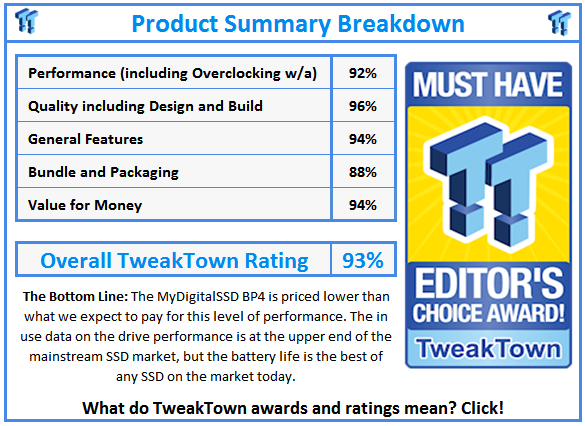Introduction
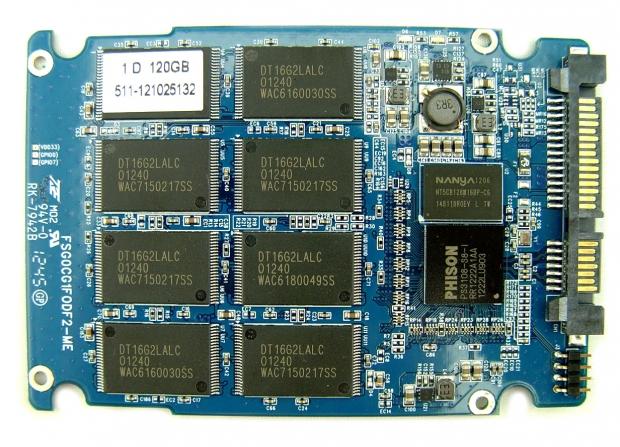
Yesterday we had the new MyDigitalSSD BP4 240GB on the test bench and were impressed with its price, price to performance ratio and industry leading notebook battery life performance. Today we have the 120GB model.
Last month we also started a quest to look at some of the newest 120/128GB SSDs and the BP4 fits right in. In 2012, we observed this capacity size starting to change, for the worst. Companies started making 128GB models with just four or eight NAND flash chips. We've shown in the past something car guys have always known, there's no replacement for displacement. A majority of SSD performance comes from parallel operations, reading and writing to several or all of the flash at the same time. The same concept one-step back in the storage world is called RAID.
The good news for shoppers is that NAND flash is getting faster. Toshiba's new 19nm Toggle 2 is faster than the 32nm and 24nm of yesterday. Another good thing is that some SSD manufactures aren't trying to cut corner.
The new MyDigitalSSD BP4 120GB still uses sixteen NAND flash chips, and because of that, this new low-cost drive is very fast by today's standards.
Specifications, Pricing and Availability
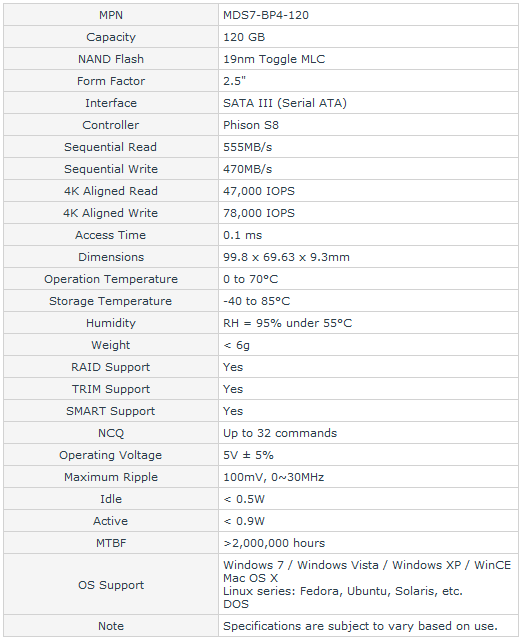
At the time of writing MyDigitalSSD is focusing on two capacity sizes in the 2.5" form factor - 120GB and 240GB. 64GB and 512GB are an option that we may see at a later data. Yesterday we published our review of the 240GB model and today we have the 120GB in the spotlight.
The BP4 120GB is rated for 555MB/s sequential reads and 470MB/s sequential writes. Random performance tops 47K IOPS read and 78K IOPS write. Not shown on the specs image is where the IOPS are delivered, BP4 has very impressive low queue depth read IOPS performance, the QD2 read measures at just over 40K in our tests, superior to OCZ's Vector, Samsung's 840 Pro and my own SSD, the MDDSSD TweakTown Chris Ramseyer Signature Edition SLC by SuperSSpeed.
The measurement was taken with compressible data and that is important to note in this review. The controller is from Phison, but it works with compressible data faster than incompressible data, just like LSI SandForce's controllers.
MyDigitalSSD backs the new BP4 series with a three year warranty, which is average for a mainstream product. The current price of $99.99 puts this drive in the lower end of the mainstream SSD segment; it borders on budget SSD prices actually.
MyDigitalSSD BP4 120GB SSD
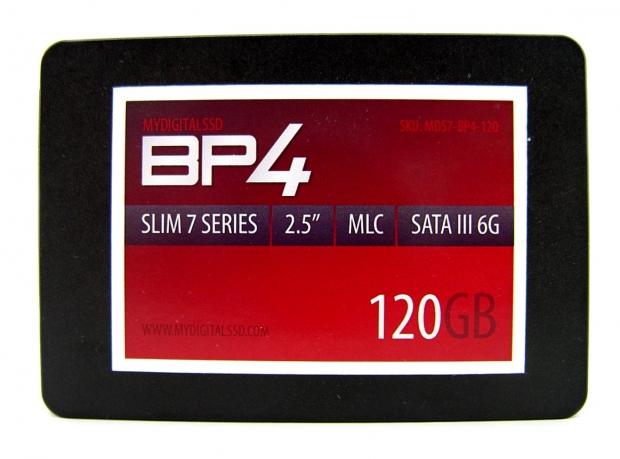
Here we get our first look at the MyDigitalSSD BP4. These drives are so new they shipped without a label and we later received the sticker just prior to the review. I'm sure MDSSD will do a much better job at getting the label straight, something I could use some practice doing.
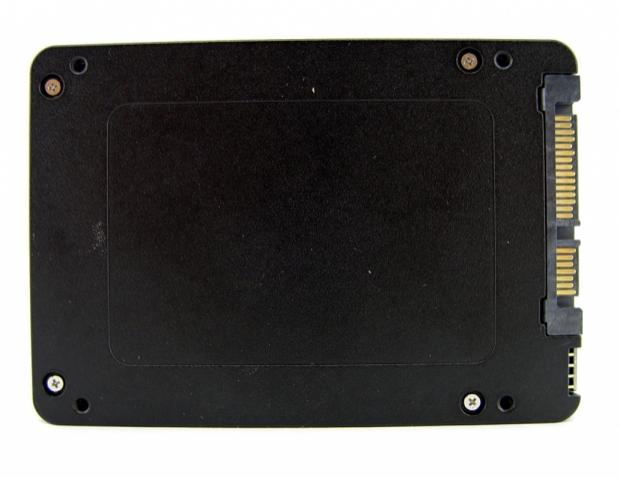
There really isn't much to see on the outside since SSDs are all about the internal components.
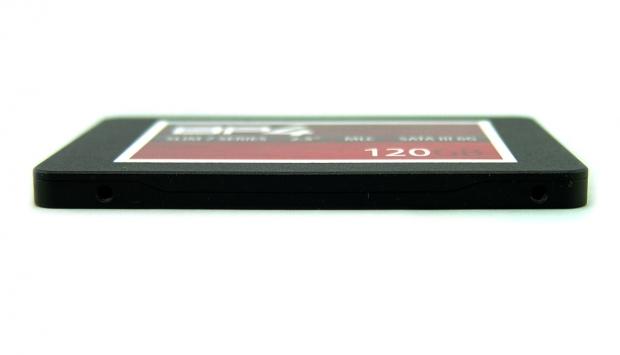
BP4 is a 7mm drive, the first from MyDigitalSSD. All of the mounting points are in the correct location for a 2.5" form factor HDD/SSD. The 7mm variant reduces the height from the top so even if your notebook is built for a 9.5mm z-height drive, the BP4 will work in its drive sled.
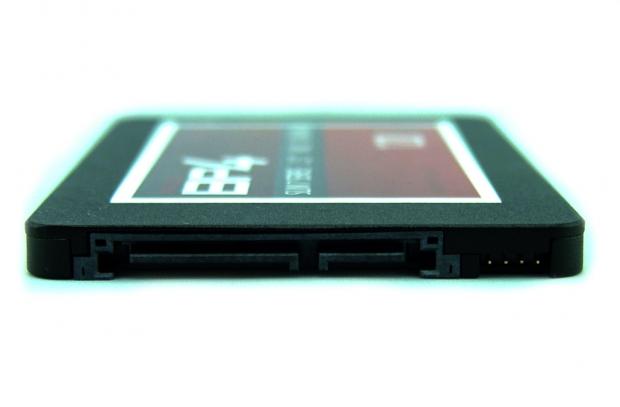
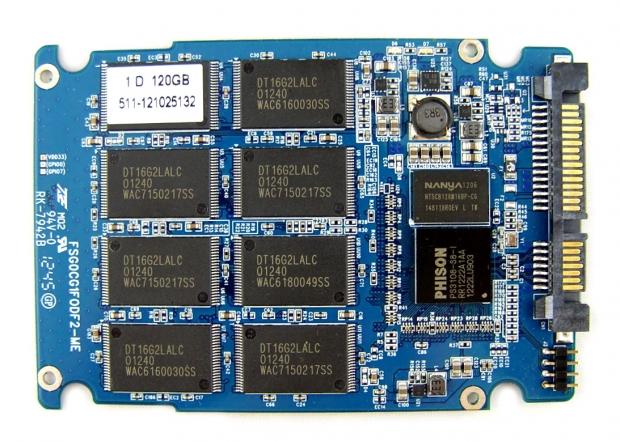
MDDSSD used the newest in flash technology, 19nm Toshiba Toggle 2 with 16K page sizes. At the time of writing there are only a small handful of SSDs shipping with this flash - SanDisk Ultra Plus, Plextor M5 Xtreme and the BP4.
The 240GB BP4 used PSC DRAM, 256MB of it, but the 120GB BP4 uses Nanya DRAM and the size drops down to 128MB. The DRAM is right next to the Phison S8 controller to reduce latency.
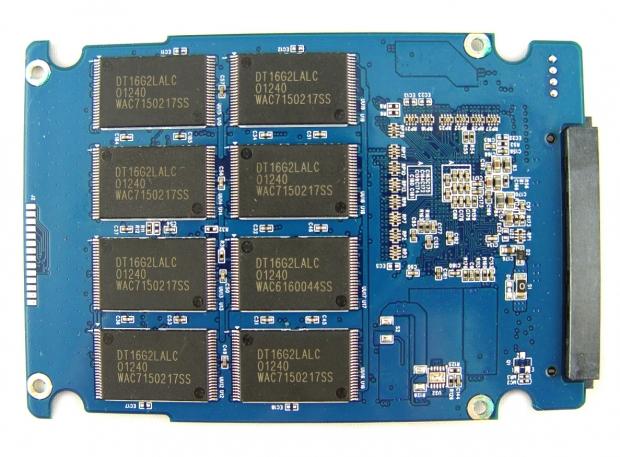
There are sixteen NAND flash chips, eight on each side. This increases the parallel I/O operations and thus increases performance.
Benchmarks - Test System Setup and ATTO Baseline Performance
Desktop Test System
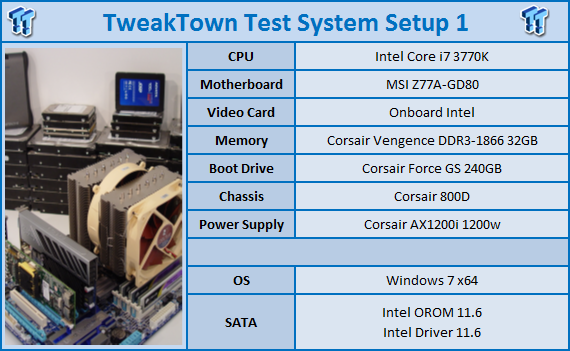
Lenovo W530 - Mobile Workstation
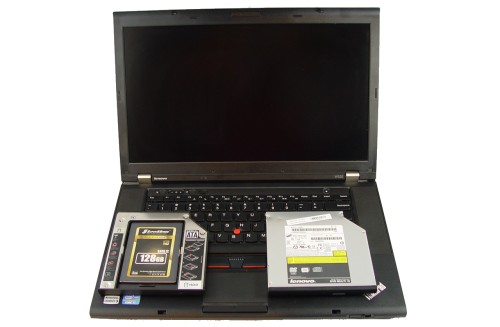
We use two systems for SSD testing. The desktop runs a majority of the tests and the Lenovo W530 runs the notebook power tests as well as the real-world file transfer benchmark.
ATTO Baseline Performance
Version and / or Patch Used: 2.34
ATTO is used by many disk manufacturers to determine the read and write speeds that will be presented to customers.
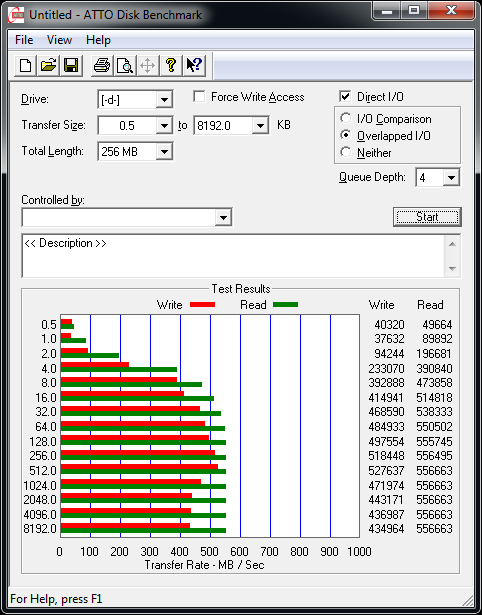
In our testing, we achieved just over 556MB/s read performance, an impressive feat for a 120GB SSD. When writing data we hit just under 530MB/s, but that speed didn't come at the lower end of the graph where we normally see it. The BP4 120GB drops off around 100MB/s when writing data at larger block sizes.
Benchmarks - Sequential Performance
HD Tune Pro
Version and / or Patch Used: 4.00
Developer Homepage: http://www.efdsoftware.com
Product Homepage: http://www.hdtune.com
HD Tune is a Hard Disk utility which has the following functions:
Benchmark: measures the performance
Info: shows detailed information
Health: checks the health status by using SMART
Error Scan: scans the surface for errors
Temperature display
HD Tune Pro gives us accurate read, write and access time results and for the last couple of years has gained popularity amongst reviewers. It is now considered a must have application for storage device testing.
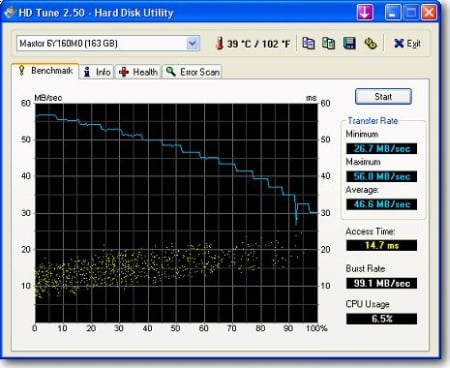
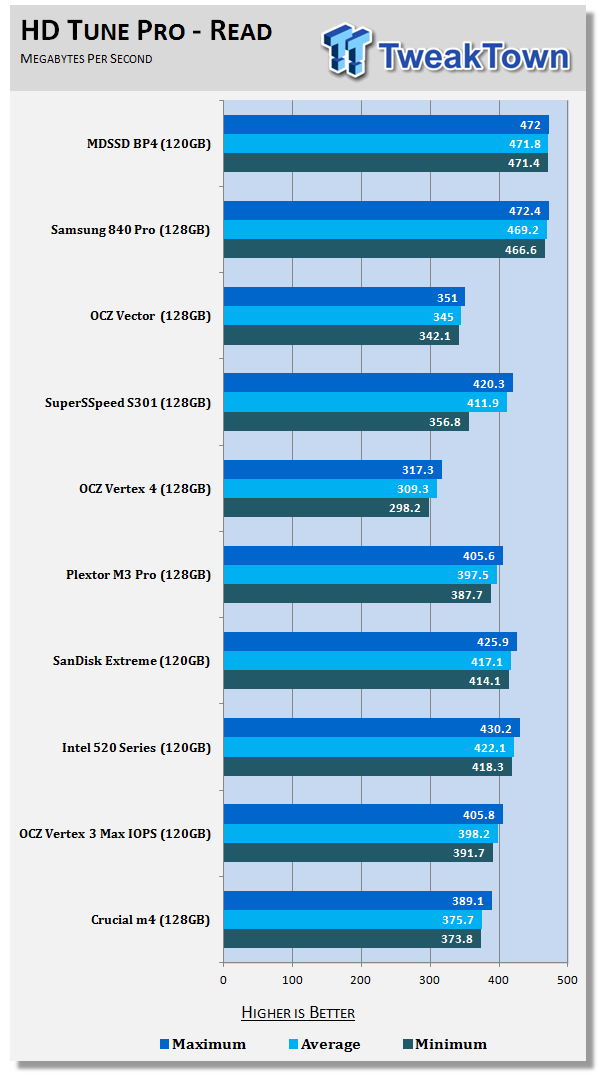
When it comes to reading sequential data, the BP4 120GB is in a very rare class of products that manages to break 450MB/s. OCZ's Vector is on the list, but it limits the single queue depth read speed to around 350MB/s, so that there is headroom for multitasking. That still doesn't change the fact that BP4 reads sequential data faster than both Samsung's 840 Pro and OCZ's Vector.
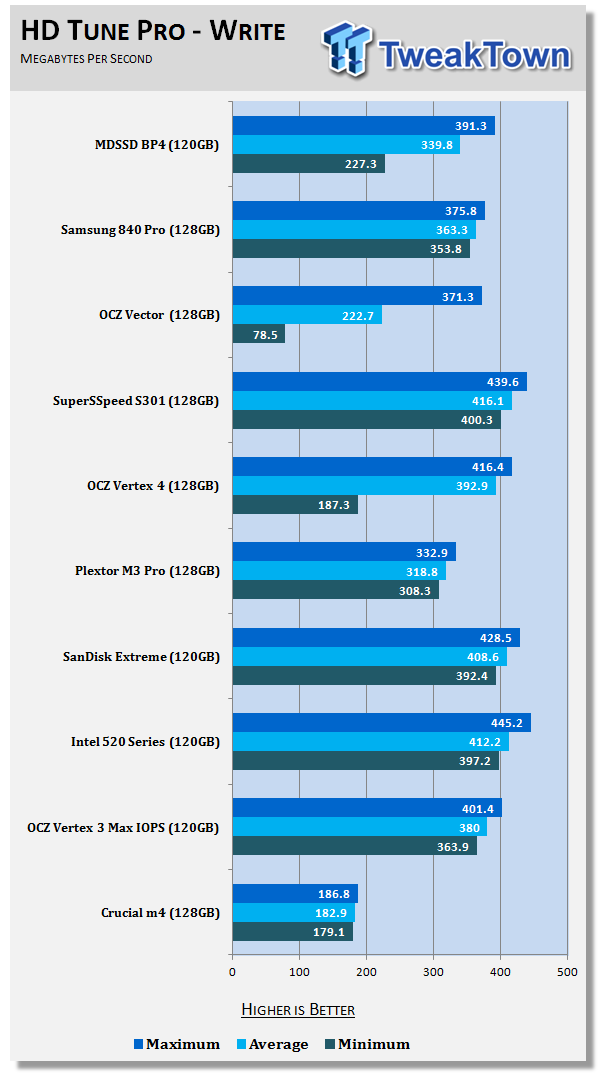
The sequential write speed is also very high on the BP4 120GB.
HD Tach - Sequential Write Performance After Random Writes
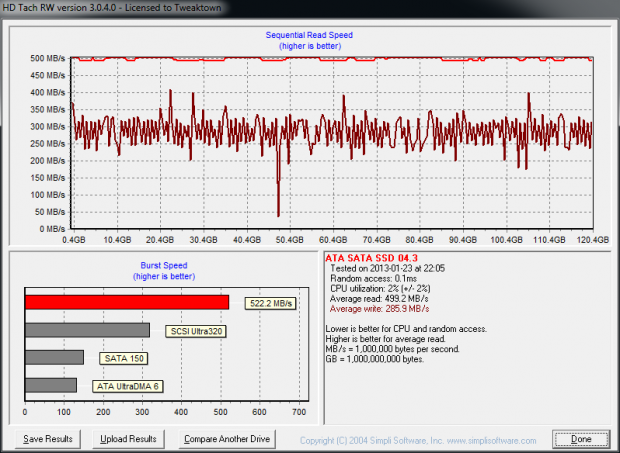
One of our new tests for 2013 is sequential write performance after heavy random writes. As you can see in the graph above, BP4 120GB does well in this test other than the single large dip.
Benchmarks - AIDA64 Random Access Time
AIDA64 Random Access Time
Version and / or Patch Used: 1.60
Developer Homepage: http://www.aida64.com
Product Homepage: http://www.aida64.com
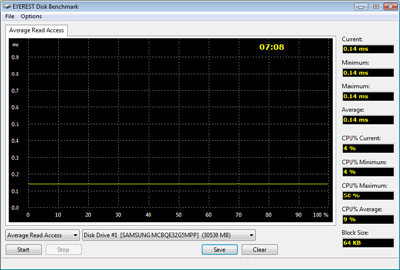
AIDA64 offers several different benchmarks for testing and optimizing your system or network. The Random Access test is one of very few if not only that will measure hard drives random access times in hundredths of milliseconds as oppose to tens of milliseconds.
Drives with only one or two tests displayed in the write test mean that they have failed the test and their Maximum and possibly their Average Scores were very high after the cache fills. This usually happens only with controllers manufactured by Jmicron.
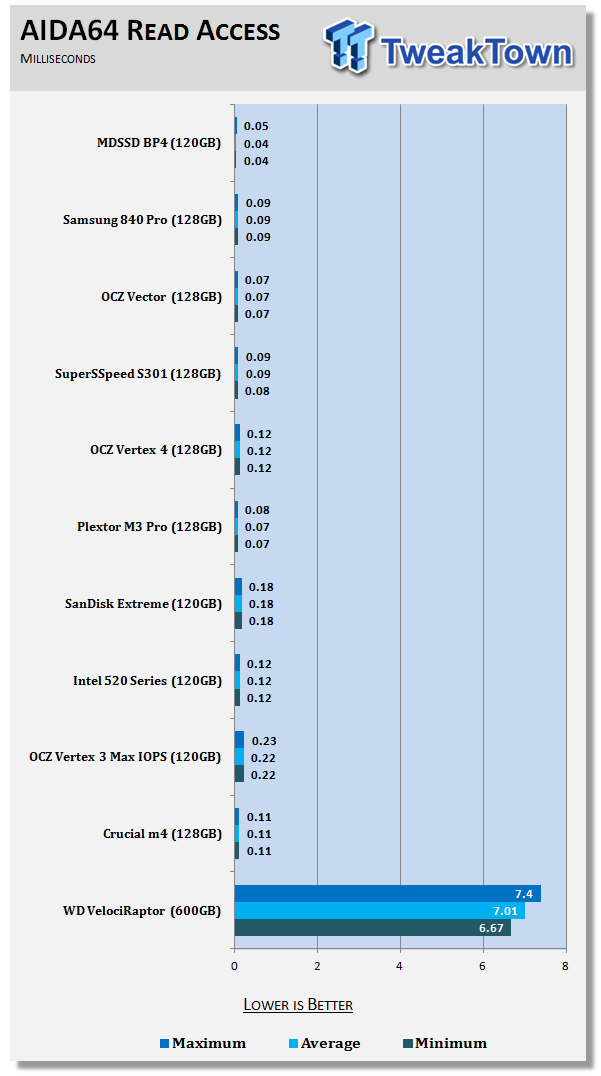
The new spare area, 256GB down to 240GB user capacity helps reduce latency. The MDSSD BP4 scores a solid .04ms in our read access test. This is a little higher than want we recorded with the 240GB version, but it's still very low.
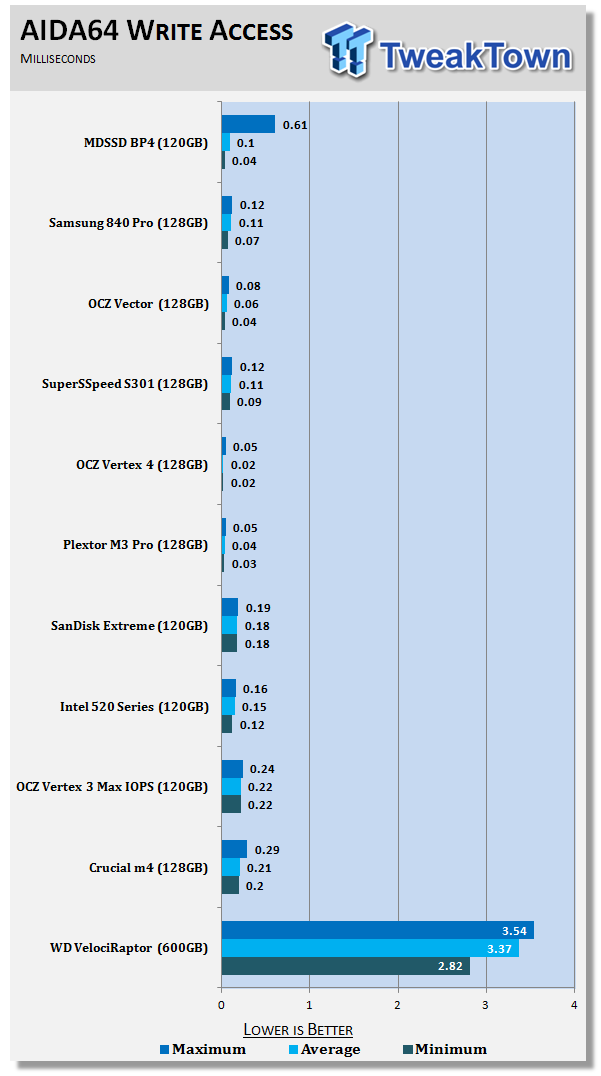
Phison, the controller maker responsible for the S8, still has a bit of an issue with write latency. The large spike in the write latency test came at the same point where the spike occurred in the sequential read after heavy random write test.
Benchmarks - Anvil Storage Utilities
Anvil Storage Utilities
Version and / or Patch Used: RC6
So what is Anvil Storage Utilities? First of all, it's a storage benchmark for SSDs and HDDs where you can check and monitor your performance. The Standard Storage Benchmark performs a series of tests, you can run a full test or just the read or the write test or you can run a single test, i.e. 4K DQ16.
Anvil Storage Utilities is not officially available yet but we've been playing with the beta for several months now. The author, Anvil on several international forums has been updating the software steadily and is adding new features every couple of months.
The software is used several different ways and to show different aspects for each drive. We've chosen to use this software to show the performance of a drive with two different data sets. The first is with compressible data and the second data set is incompressible data. Several users have requested this data in our SSD reviews.
0-Fill Compressible Data
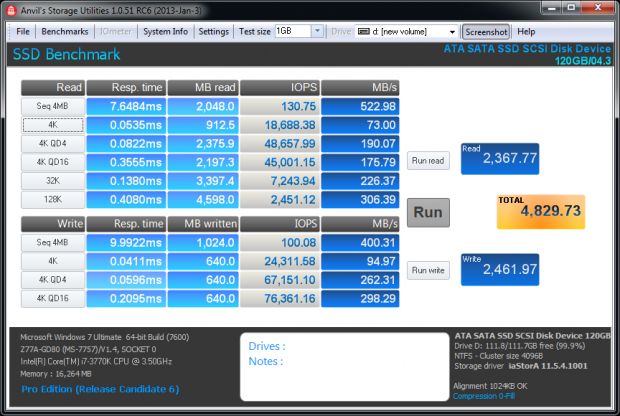
Incompressible Data
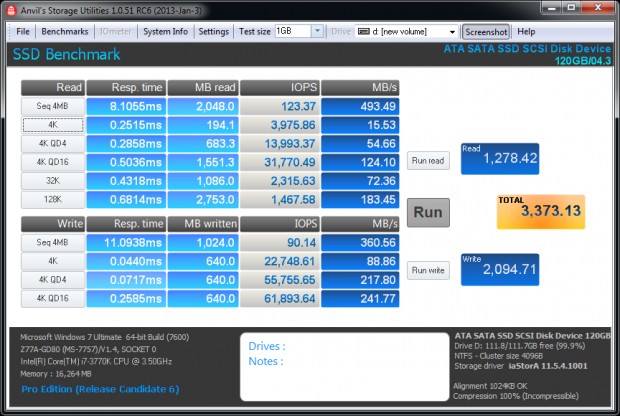
After looking at the two results above you might think BP4 has a SandForce controller, but it doesn't. The new S8 programming not only creates a 7% over-provision, but also brings in a SandForce like scheme of working with compressible data faster than incompressible data.
Read IOPS through Queue Depth Scale
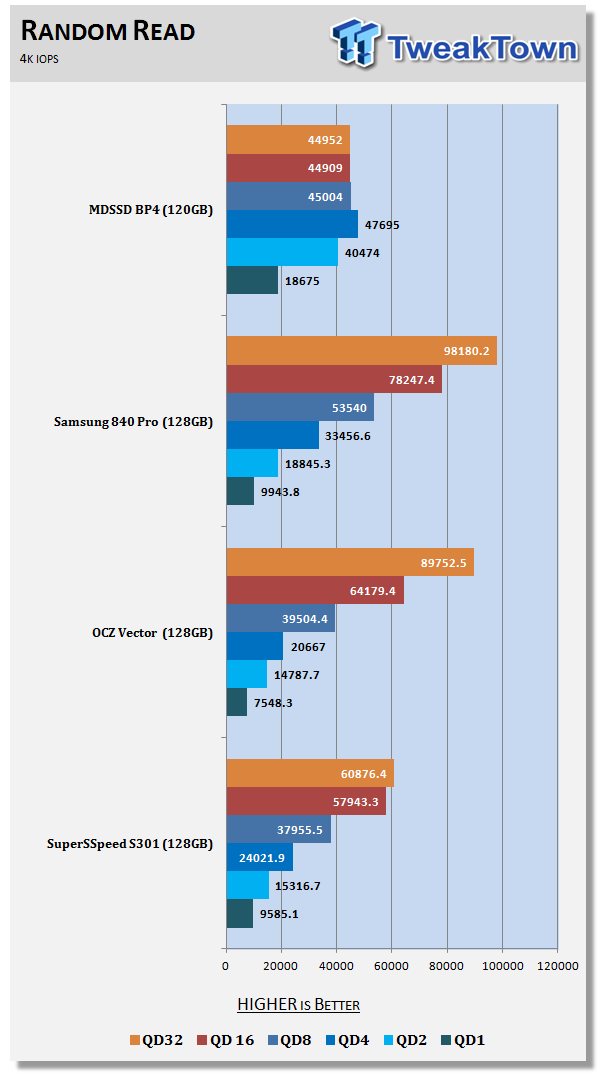
BP4 has very impressive low queue depth IOPS performance, but the high queue depth performance levels off. For consumers this isn't a very big deal since you rarely get to high queue depths.
Scaling Write IOPS through Queue Scale
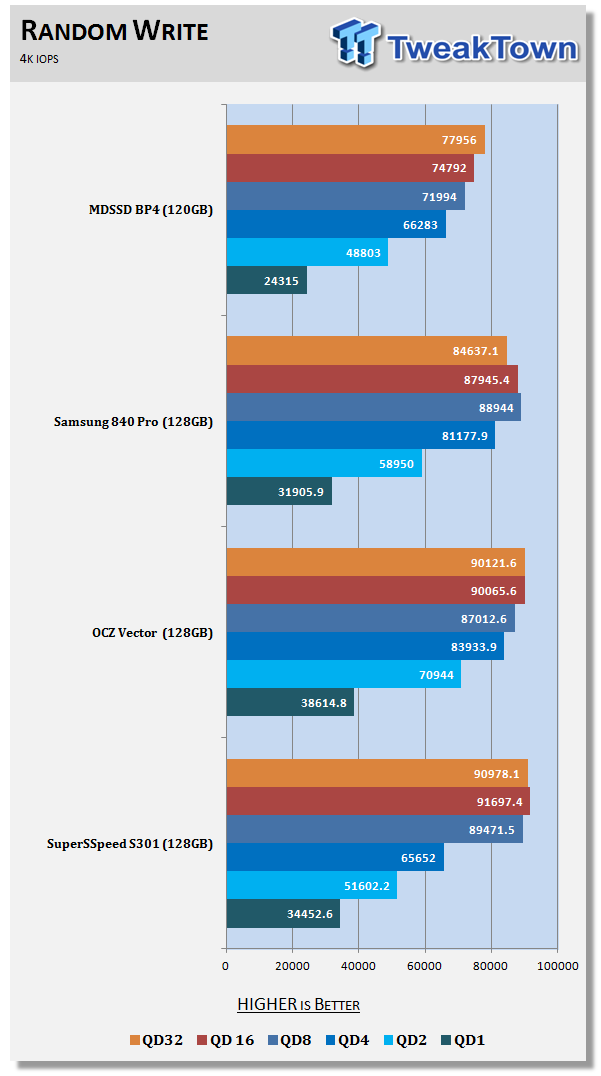
The IOPS performance is much better than the previous Bullet Proof drives we've tested. At the top end we measured nearly 78K. The low queue depth IOPS is good for a budget model.
Benchmarks - CrystalDiskMark
CrystalDiskMark
Version and / or Patch Used: 3.0 Technical Preview
Developer Homepage: http://crystalmark.info
Product Homepage: http://crystalmark.info/software/CrystalDiskMark/index-e.html
Download here: http://crystaldew.info/category/software/crystaldiskmark
CrystalDiskMark is a disk benchmark software that allows us to benchmark 4K and 4K queue depths with accuracy.
Key Features:-
* Sequential reads/writes
* Random 4KB/512KB reads/writes
* Text copy
* Change dialog design
* internationalization (i18n)
Note: Crystal Disk Mark 3.0 Technical Preview was used for these tests since it offers the ability to measure native command queuing at 4 and 32.
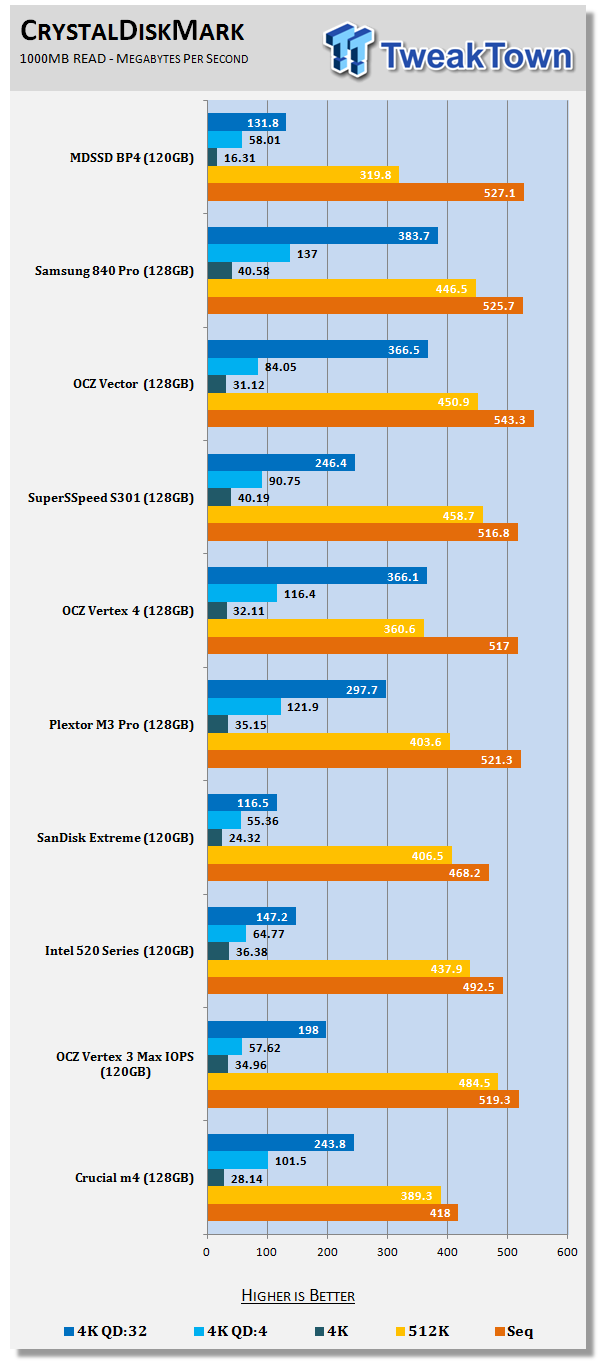
The single request 4K read speed is down to every other drive on the chart. CDM uses incompressible data so that explains the loss of performance in this test. BP4 120GB scales well through the queue depths, but this is clearly an area where the performance isn't as high as other top performing drives on the market today.
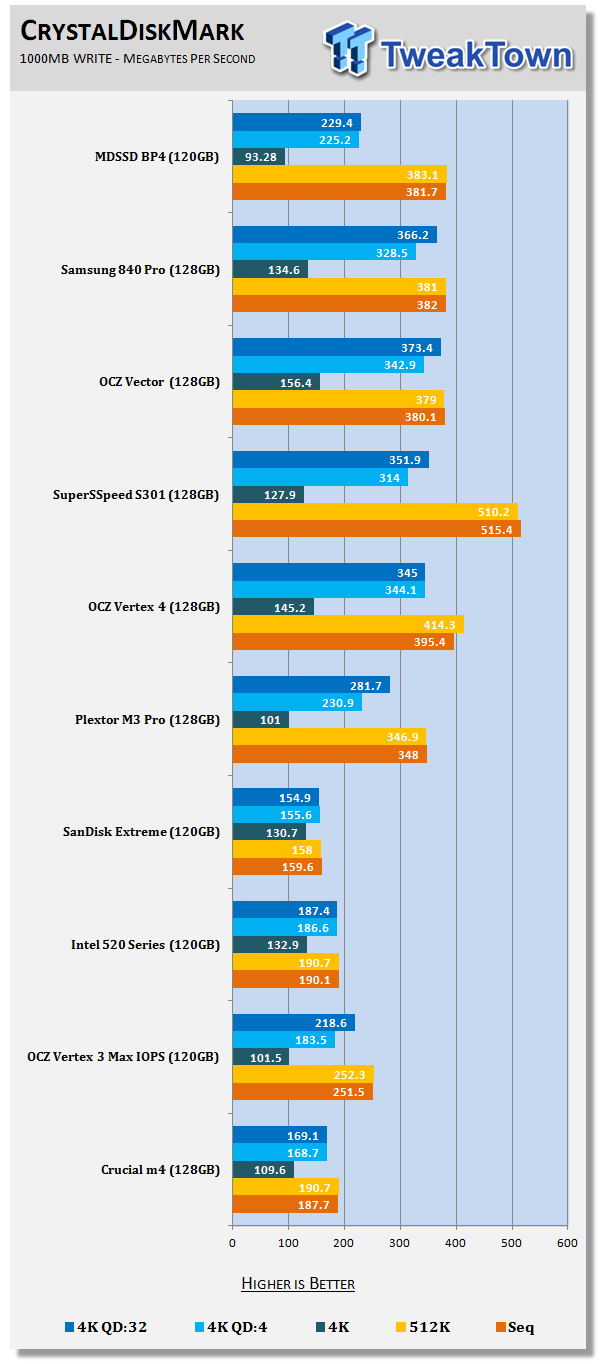
The 4K single request write performance is also lower than just about everything on the chart. Looking at the bottom of the chart we see a group of drives with LSI SandForce controllers and see the SandForce brick wall that is common on most SF drives. BP4 doesn't have the same brick wall and scales well from QD1 to QD4.
Benchmarks - PCMark Vantage Hard Disk Tests
PCMark Vantage - Hard Disk Tests
Version and / or Patch Used: 1.0.0
Developer Homepage: http://www.futuremark.com
Product Homepage: http://www.futuremark.com/benchmarks/pcmark-vantage/

PCMark� Vantage is the first objective hardware performance benchmark for PCs running 32 and 64 bit versions of Microsoft� Windows Vista�. PCMark Vantage is perfectly suited for benchmarking any type of Microsoft� Windows Vista PC from multimedia home entertainment systems and laptops to dedicated workstations and high-end gaming rigs. Regardless of whether the benchmarker is an artist or an IT Professional, PCMark Vantage shows the user where their system soars or falls flat, and how to get the most performance possible out of their hardware. PCMark Vantage is easy enough for even the most casual enthusiast to use yet supports in-depth, professional industry grade testing.
FutureMark has developed a good set of hard disk tests for their PCMark Vantage Suite. Windows users can count on Vantage to show them how a drive will perform in normal day to day usage scenarios. For most users these are the tests that matter since many of the old hat ways to measure performance have become ineffective to measure true Windows performance.

HDD1 - Windows Defender
HDD2 - Gaming
HDD3 - Windows Photo Gallery
HDD4 - Vista Startup
HDD5 - Windows Movie Maker
HDD6 - Windows Media Center
HDD7 - Windows Media Player
HDD8 - Application Loading
With a very high sequential read speed, I was a bit surprised to find middle of the road performance in Vantage. Vantage stresses more than just sequential read performance, but a few of the tests rely on sequential reads for most of the test.
Benchmarks - PCMark Vantage - Drives with Data Testing
For a complete breakdown on the Drives with Data Testing please read this article. You will be able to perform this test at home with the files provided in the article - full instructions are included.
- Brief Methodology
SSDs perform differently when used for a period of time and when data is already present on the drive. The purpose of the Drives with Data testing is to show how a drive performs in these 'dirty' states. SSDs also need time to recover, either with TRIM or onboard garbage collection methods.
Drives with Data Testing - 25%, 50%, 75% Full States and Dirty / Empty Test
Files needed for 60 (64GB), 120 (128GB), 240 (256GB)
60GB Fill - 15GB, 30GB, 45GB
120GB Fill - 30GB, 60GB, 90GB
240GB Fill - 60GB, 120GB, 160GB
Empty but Dirty - a test run just after the fill tests and shows if a drive needs time to recover or if performance is instantly restored.

When you start to pile data on the drive, the MDSSD BP4 slows quite a bit. I just built a system with the 240GB drive and noticed the performance slowdown after getting the system finished with all of the software installed.
The performance is still very good, but what you see on the chart between BP4 and the 840 Pro is accurate. 840 Pro in this capacity still has some issues that you can read about in our review. The price difference between these two drives is significant and the price vs. performance ratio would lead me to look at the BP4 over the 840 Pro in this capacity size.
Benchmarks - BootRacer
BootRacer - System Boot Time
Version and / or Patch Used: 4.0
Developer Homepage: Greatis
Product Homepage: BootRacer
Download here: http://www.greatis.com/bootracer/download.htm
Note: In this test we use the Lenovo W530 Mobile Workstation loaded with an operating system and several program files. The data on the drive at the time of the test is 45GB. The second test, 50GB Free, was run with the drives filled with block data until only 50GB of free capacity remained.
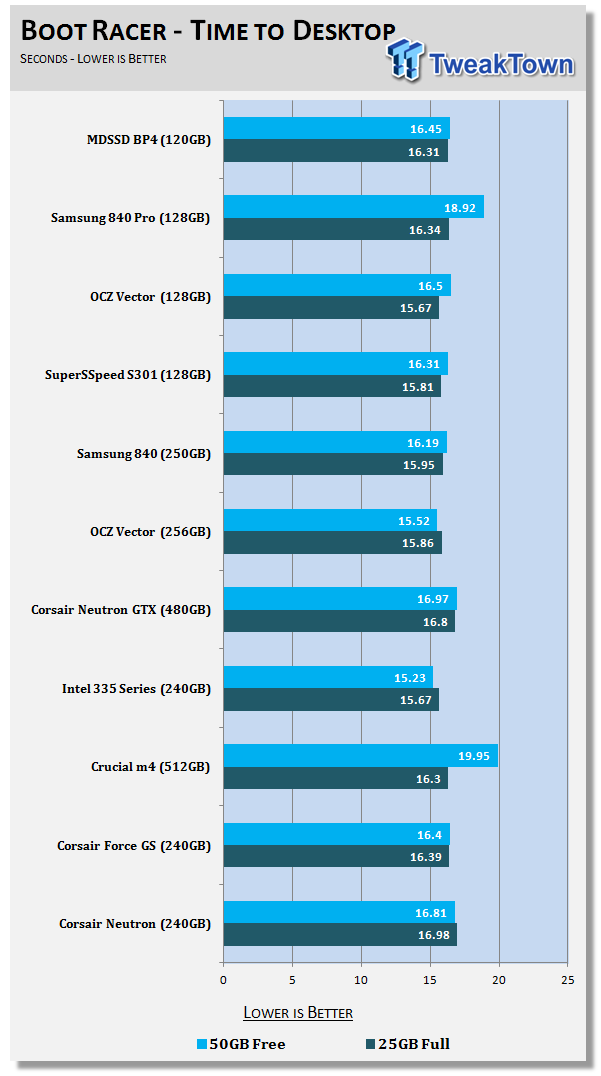
In the previous chart we observed performance loss due to data residing on the flash as being constant. The drop off is rapid, but yet steady from 25% to 75% fill. Because of that, boot times don't differ much between just 25GB used and 70GB used on the drive.
Most users will agree that constant performance is important. No one likes a drive that is fast out of the gate and then slows significantly over time.
Benchmarks - DiskBench
DiskBench - Directory Copy
Version and / or Patch Used: 2.6.2.0
Developer Homepage: Nodesoft
Product Homepage: DiskBench
Download here: http://www.nodesoft.com/diskbench/download
Note: In this test we use the Lenovo W530 Mobile Workstation and a SuperSSpeed S301 SLC 128GB SSD to move a 15GB block of data to and from the target drive. This is part of our real world test regiment. Roughly 45GB of data resides on the target drive before the '15GB Block' is transfer. The 15GB Block is the same data we built for the Data on Disk Testing and is a mix of compressible and incompressible data.
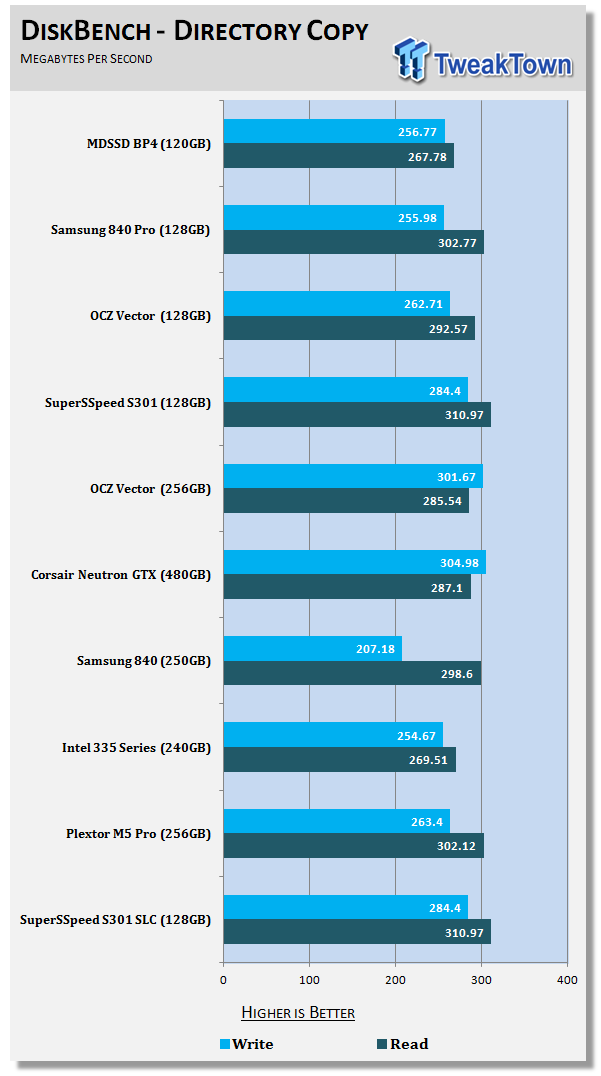
Transferring data to and from the BP4 is a pleasant task. This drive does very well in these tests. The Windows NTFS file system only allows us to achieve around 300MB/s and the BP4 gets very close to that performance.
Benchmarks - Power Testing
Bapco MobileMark 2012 1.5
Version and / or Patch Used: 2012 1.5
Developer Homepage: http://www.bapco.com
Test Homepage: http://www.bapco.com
MobileMark 2012 1.5 is an application-based benchmark that reflects usage patterns of business users in the areas of office productivity, media creation and media consumption. Unlike benchmarks that only measure battery life, MobileMark 2012 measures battery life and performance simultaneously, showing how well a system design addresses the inherent tradeoffs between performance and power management.
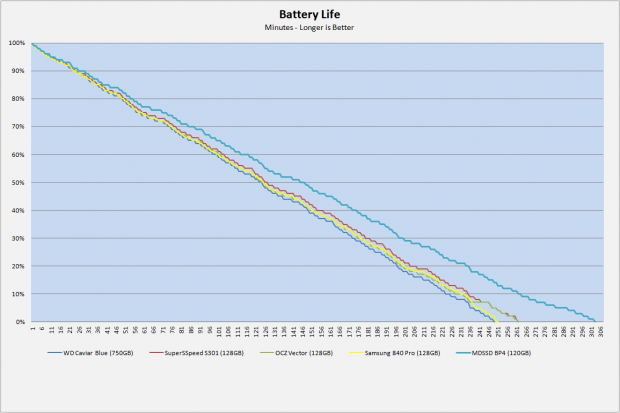
The MyDigitalSSD BP4 delivers class leading battery life in our Lenovo W530 battery life test.
PCMark Vantage HDD Test - Power Draw
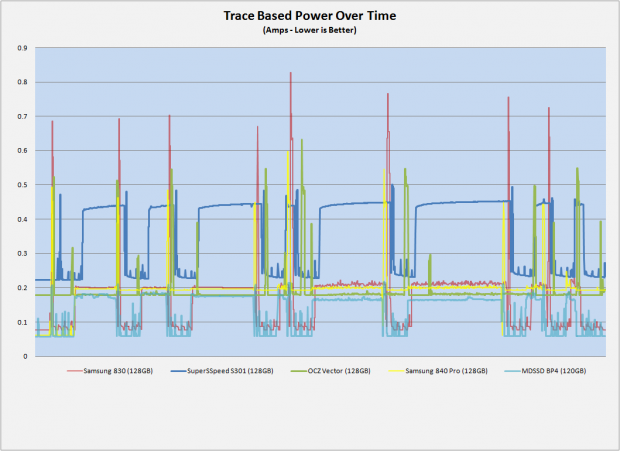
Here we see how the MDSSD BP4 is able to deliver such long battery life performance in our notebook.
BP4 has lower idle power consumption than everything else on the chart and the peaks when writing random data are very low. In every one of the five point categories, idle, random read, random write, sequential read and sequential write the BP4 outperforms everything else on the chart.
Final Thoughts
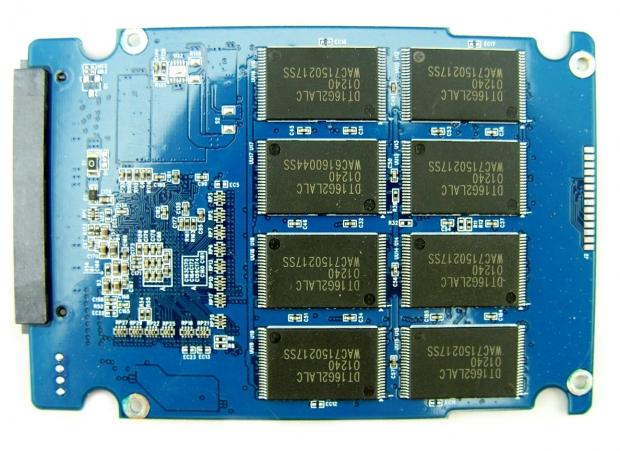
The MyDigitalSSD BP4 is an interesting SSD. The Phison S8 when released several months ago was a nice mainstream offering, but the new programming and firmware puts the Bullet Proof in a new category. The performance offered isn't at Vector or 840 Pro levels, but it isn't too far behind, at least right out of the box. When the BP4 has data on it the performance decreases quite a bit, but that still higher than what we consider for a true low-end, ultra-budget SSD.
So, that really leads us to the interesting part. I hate to use it, but it fits so well. The BP4 raises the bar of what a mainstream SSD is. The price is what we once considered budget, lower than mainstream, but the performance is higher than what we once classified at mainstream.
This is a revolution in the mainstream market. Normally we only get excited about this sort of thing happening in the ultra performance side where Vector and the 840 Pro play, but I'm excited. Until now it was business as usual for mainstream, as we saw just days ago with the SanDisk Ultra Plus. The 256GB Ultra Plus sells for around $210, but the BP4 240GB is only $180, and it's faster.
When it comes to the 120GB capacity size, things get even more interesting. The current push is to reduce the number of NAND flash chips in these lower capacity models. 128GB is the new 60GB while at the same time 512GB is the new 256GB... with 1TB just around the corner to displace 512GB. BP4 didn't fall into the cookie cutter pattern and retains the proven method of sixteen NAND flash chips working together to keep performance high.
Going into the review, we thought a sixteen NAND solution would draw more power than the new four and eight chip designs, but that wasn't the case. BP4 offers the lowest idle and in-use power consumption numbers we've published to date from the drives we've tested so far.
The MyDigitalSSD BP4 120GB is available today for $99.99 at Amazon and MyDigitalDiscount.com. It offers best in class battery life, impressive performance and is stable out of the box.

